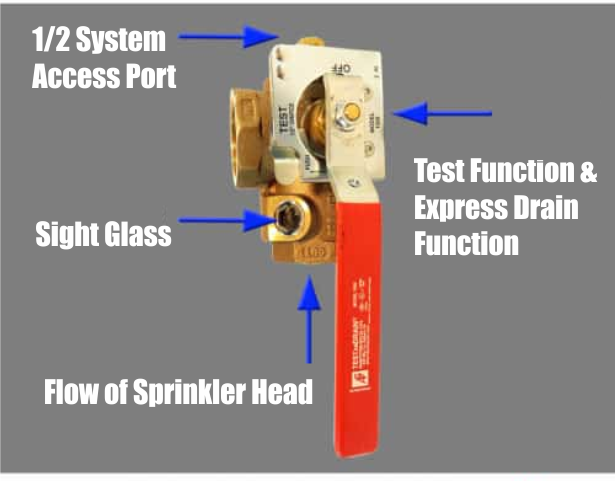What is a test and discharge valve?
Test and drain valve is a type of valve with both test and quick drain functions. Consider a combination of a ball valve and an inspector test valve, except that it is produced as a single unit, making it much more convenient. Similar to the compact and easy-to-use nature of commercial and residential lift assemblies, test and discharge valves are a step forward for the fire protection industry as they simplify system installation by eliminating redundant components. Compared to a standard ball valve and a separate inspector test valve, Test and Drain means lower cost, fewer parts, easier installation and multiple uses. With an integrated design, standard test and drain valves come with common features: single-handle ball valve one 5.6K or 8.0K test port tamper-resistant sight glass one tapped and plugged port for system access

Uses of test and discharge valves:
Test and drain valves provide installation and maintenance applications for wet pipe fire sprinkler systems. Wet pipe systems are undoubtedly the “Ole Reliable” in the fire sprinkler industry. They are known for their simple design and consistent performance. Other systems—such as dry or flood—have unique advantages but require more equipment, which provides greater potential for system failures and deficiencies. For this reason, most tests and drains are designed to meet the needs of wet fire sprinkler systems. In particular, the drain function allows the system to be drained quickly and the test function is useful for testing the system that assesses the water supply and ensures that it is readily available in the riser and on the system side of the main check valve. Since a test and drain has the ability to drain the system, it can act as the main drain in a wet pipe system. Additionally, test and discharge can replace ball valves in commercial or residential risers. The main advantage of test and discharge is its ability to perform the required system tests in accordance with NFPA 25. These valves are equipped with a sight glass to provide visual confirmation of water flow through the system.
Placement and installation of test and drain valve:
As mentioned above, there is no need for a special location for the test and drain valve. More traditional inspector test valves were placed at the bottom of the system, which is very useful for identifying system clogs. However, the test and discharge are usually found as part of the riser assembly. In a combined sprinkler/pipe system, a test and drain valve is beneficial because it helps facilitate flow testing. To do this, the valve must be located downstream of the floor control valve and connected to a drain riser. The test and discharge valves have openings capable of simulating the discharge of a 5.6 K sprinkler head that tests the floor flow switch. In this test scenario, the water flow alarm should be activated within 90 seconds. Through the water flow test, the alarm system and the panel are also tested because it must show the water flow. Additionally, a test and dump can provide system security and a controlled test environment. When used in a commercial or residential riser in an upstairs room, the test function is not accessible to the public, eliminating the risk of tampering and setting alarms. In addition, the loft chamber can be controlled and adjusted, allowing for a local, consistent and controlled testing environment. This in itself is a huge advantage!
What are the requirements of the test and drain valve?
Although we covered most of the system requirements for a test and drain in the previous section, the valves themselves must also conform to a specific code. Valves used with wet pipe sprinkler systems must have a minimum operating pressure of 175 psi. If the system has a higher working pressure, the valves must function according to the system requirements. In addition, valves must have what the NFPA refers to as “limited leakage after removal of all elastic material.” The purpose of this is to show how the valve will perform during a fire or with age and to ensure that large amounts of water do not flow unchecked into the system in the event of a drain line failure. As you move forward and begin the process of selecting a test and drain valve, it is important to keep this information in mind.

